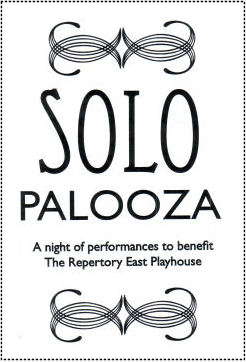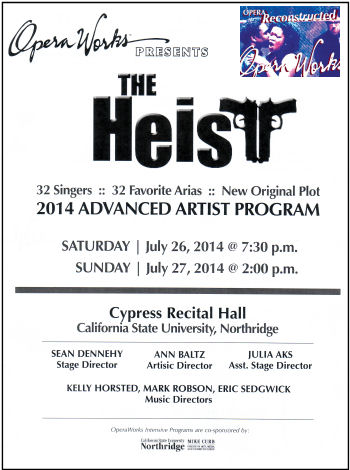
 Two or so years ago, we discovered a really interesting program at CSUN. It is called Operaworks, and it’s goal is to make better Opera singers. The advanced artist program, which just concluded, has a slightly different specific goal: to teach opera singers how to “be” on stage. In their training, opera singers are taught to stand and sing in a formalized position. But to be effective in opera, they need to learn how to act — how to move, how to interact with others, how to tell stories with their movements, how to create personas that go beyond the areas. Each year in this program they bring together 30 or so graduate or newly performing singers. They come up with a theme, personas, and then select arias from their repertoires that might fit. They then improvise these areas into a through story, present two performances, and its gone for the year.
Two or so years ago, we discovered a really interesting program at CSUN. It is called Operaworks, and it’s goal is to make better Opera singers. The advanced artist program, which just concluded, has a slightly different specific goal: to teach opera singers how to “be” on stage. In their training, opera singers are taught to stand and sing in a formalized position. But to be effective in opera, they need to learn how to act — how to move, how to interact with others, how to tell stories with their movements, how to create personas that go beyond the areas. Each year in this program they bring together 30 or so graduate or newly performing singers. They come up with a theme, personas, and then select arias from their repertoires that might fit. They then improvise these areas into a through story, present two performances, and its gone for the year.
Today we saw the second performance. Sorry, you missed it. Try again next year.
This year’s performance was called “The Heist”. It was based on the story of an imaginary crime family called the Mezzos. I certainly won’t be able to tell you the full story, because I simply didn’t catch it all. But let’s try (and note that I’m doing this from memory, and was a bit drowsy from my migraine meds during the first act).
The first act was called “The Family Meeting”. It was essentially a cocktail party where different members of the Mezzo family were interacting. These included Giovanni Mezzo and his wife Holly. After a heist went wrong, Giovanni has gone into hiding. Holly is the mother of Amber Rose, Angela, Annie, Ricardo, and adopted son Angky. Annie lives in the bottle and is a hopeless drunk; AmberRose is the daddy’s girl; Angela is the caretaker of the family; Ricardo is the oldest son, trying to take his father’s place; and Angky, the adopted son who is betrothed to Anastasia, part of the family that killed Giovanni’s father. Also at the party is Rebecca Mezzo-Carminotti, widow of Giacomo Carminotti and younger sister of Holly. Rebecca is the mother of Tara, who on her last job killed a bank teller and is suffering from PTSD. Also at the party is Lauren O’Donnell Mezzo, Ricardo’s wife; Baby, who got caught up in the family; and Mark Markson, the family legal counsel and sometimes pianist. As the party goes on, we move from character to character seeing the interplay; the party concludes with the announcement that there is going to be one last heist.
Arias in Act One were: Adele’s Laughing Song (Die Fledermaus | Johann Strauss) [Annie Sherman as Annie Mezzo]; Czàrdàs (Die Fledermaus | Johann Strauss) [Rebecca Peterson as Rebecca Mezzo-Carminotti]; O wär ich schon (Fidelio | Ludwig van Beethoven) [Anastasia Malliaras as Anastasia Basso]; The Tower Aria (The Turn of the Screw | Benjamin Britten) [Tara Morrow as Tara Mezzo-Carminotti]; La Promessa (Giacchino Rossini) [Lauren Corcoran as Lauren O’Donnell Mezzo]; Dearest Mama (The Ballad of Baby Doe | Douglas Moore) [Cristina Foster as Baby]; Una Furtiva Lagrima (L’Elisir D’Amore | Gaetano Donizetti) [Ricardo Mota as Ricardo Mezzo]; Steal Me, Sweet Thief (The Old Maid and the Thief | G. Menotti) [Angela De Venuto as Angela Mezzo]; When The Air Sings of Summer (The Old Maid and the Thief | G. Menotti) [Angky Budiardjono as Angky Mezzo]; Don’t Say a Word (Dead Man Walking | Jake Heggie) [Holly Seebach as Holly Mezzo]; and I Go To Him (The Rake’s Progress | Igor Stravinsky) [AmberRose Dische as AmberRose Mezzo]. Mark Robson was at the piano.
The memorable performance in Act One was Annie Sherman as the drunk Annie Mezzo — she was just a delight to watch through the entire act, both as the drunk and how she interacted with others.
Act Two is the actual heist, and takes place at the Bank. The characters we meet here are Erin Desjardins, a student about to graduate from high school and her French cousin, Rachelle Desjardins; Manon Elias, a Kim Kardashian-type at the bank with her boyfriend, commercial real estate giant Andrew Gold. Mary Silverstein, the bank manager and Magdaline Small, the bank teller; Katherine Sullivan, a high-school English teacher; Noel Strand and Sean Faust, the bank guards; Kelly the bank heist manager and her new robber Crystal; and Karlos Keys, a security guard who enjoys playing piano more. Most of the act is the interaction between the characters. When the heist occurs, the manager is forced to open the silver vault. Katherine organizes the guard and the others to overpower the watchman, and they storm the vault. During the melee, Samantha Mezzo is shot.
Arias in Act Two were Laurie’s Song (The Tender Land | Aaron Copland) [Erin White as Erin Desjardins]; O Mio Babbino (Gianni Schicchi | Giacomo Puccini) [Rahel Moore as Manon Elias]; En Fermant Les Yeux (Manon | Jules Massenet) [Andrew Zimmerman as Andrew Gold]; Nun Eilt Herbei (The Merry Wives of Windsor | Otto Nicolai) [Kelly Rubinsohn as Kelly]; Meine Lippen, Sie Küssen (Guiditta | Franz Lehar) [Crystal Kim as Crystal]; Je Suis Encor (Manon | Jules Massenet) [Rachel Rosenberg as Rachelle Desjardins]; Come Now a Roundel (A Midsummer Night’s Dream | Benjamin Britten) [Magdaline Small as Magdaline Small]; The Silver Aria (The Ballad of Baby Doe | Douglas Moore) [Mary Harrod as Mary Silverstein]; Prendi, Per Me (L’Elisir D’Amore | Gaetano Donizetti); and Chacun Le Sait (La Fille Du Régiment | Gaetano Donizetti) [Katherine Sullivan as Katherine Sullivan]. Pianists were Nola Strand and Kelly Horsted.
Notable performances in Act Two were Crystal as the naive thief and Erin White with her opening song. My wife liked the clueless bank manager (Mary Harrod) and Rahel Moore as the golddigger.
Act Three takes place at the hospital afterwards. The characters we meet here include the hospital personnel: Sangeetha Ekambaram the head nurse; Brenna Johnson, an RN; her husband Dr. Joe Johnson; and Eric Zingermann, the intake clerk who dreams of a bigger career on the concert stage. We also meet Sarah Westbrook, a gold-digging bored housewife who has secret assignations with Dr. Joe; Megan, a local hypochondriac; Alice Beurre a new bride and her maid of honor, Beth; Marina, the new clown doctor, and Tascha, whose father was injured picking strawberries. Lastly, there is the aforementioned Samantha Mezzo, who was shot in the heist. This act is mostly the interactions between the characters, concluding with Samantha’s death.
Arias in Act Three were: Ophelia’s Mad Scene (Hamlet | Ambroise Thomas) [Megan Supina as Megan]; O Mon Fernand / Kommit Ein Schlanker (La Favorite | Gaetano Donizetti) / (Der Freischütz | Carl Maria von Weber) [Alice Chung as Alice Beurre / Elizabeth Sterling as Beth]; Je Veux Vivre (Roméo Et Juliette | Charles Gounod) [Sangeetha Ekambaram as Sangeetha Ekambaram]; Pauline’s Aria (Pique Dame | Peter Illyich Tchaikovsky) [Marina Kesler as Marina]; Madamina, Il Catalogo é questo (Don Giovanni | W. A. Mozart) [Brent Hetherington as Dr. Joe Johnson]; Svegliatevi Nei Core [Giulio Cesare | George Frederick Händel) [Tascha Anderson as Tascha]; Ouvre Ton Coeur (Georges Bizet) [Sarah Dudley as Sara Westbrook]; Things Change, Jo (Little Women | Mark Adamo) [Brenna Casey as Brenna Johnson]; and Emily’s Aria (Our Town | Ned Rorem) [Samantha Lax as Samantha Mezzo]. Eric Sedgwick was the pianist.
Notable performances in Act Three were Megan as the hypochondriac. My wife liked Brenna Casey.
Turning to the technical side, umm, well they didn’t say much. Sean Dennehy was the Stage Director, Julia Aks was the Assistant Stage Director, and Ann Baltz as the Artistic Director.
Look for the next Operaworks production in July 2015. You can sign up for their mailing list at http://www.operaworks.org/.
[Ob. Disclaimer: I am not a trained theatre critic; I am, however, a regular theatre audience. I’ve been attending live theatre in Los Angeles since 1972; I’ve been writing up my thoughts on theatre (and the shows I see) since 2004. I do not have theatre training (I’m a computer security specialist), but have learned a lot about theatre over my many years of attending theatre and talking to talented professionals. I pay for all my tickets unless otherwise noted. I believe in telling you about the shows I see to help you form your opinion; it is up to you to determine the weight you give my writeups.]
Upcoming Theatre and Concerts: August starts with “Family Planning” at The Colony Theatre (FB) on 8/2. This is followed by “Buyer and Cellar” at the Mark Taper Forum on 8/9, and “Broadway Bound” at the Odyssey on 8/16 (directed by Jason Alexander). The following weekend we’ll be in Escondido, where there are a number of potential productions… including “Two Gentlemen of Verona” at the Old Globe, and “Pageant” at the Cygnet in Old Town. What they have at the Welk (“Oklahoma“), Patio Theatre (“Fiddler on the Roof“), and Moonlight Stage (“My Fair Lady“) are all retreads. August will end with the aforementioned “An Adult Evening of Shel Silverstein” at REP East (FB). I’m just starting to fill out September and October — so far, the plans include “The Great Gatsby” at Repertory East (FB), “What I Learned in Paris” at The Colony Theatre (FB), and “Pippin” at the Pantages (FB). November is also shaping up, with dates held for “Big Fish” at Musical Theatre West (FB), “Handle with Care” at The Colony Theatre (FB), the Nottingham Festival, “Sherlock Holmes and the Suicide Club” at REP East (FB), “Kinky Boots” at the Pantages (FB), and “She Loves Me” at Chance Theatre (FB) in Anaheim. As always, I’m keeping my eyes open for interesting productions mentioned on sites such as Bitter-Lemons, and Musicals in LA, as well as productions I see on Goldstar, LA Stage Tix, Plays411.


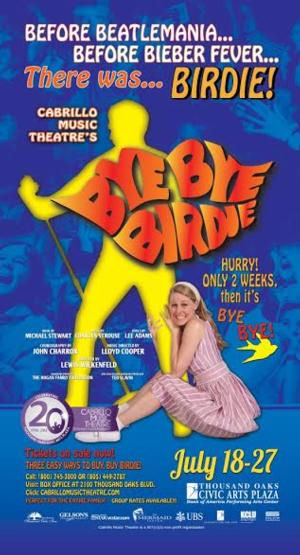
 Last night, at the
Last night, at the 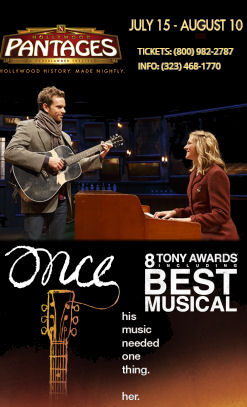
 “It’s everything that “
“It’s everything that “
 Back in the year 1610 (or perhaps it was 1611), a fellow by the name of Bill Shakespeare wrote a little play called “
Back in the year 1610 (or perhaps it was 1611), a fellow by the name of Bill Shakespeare wrote a little play called “

 Some people wonder how I pick the shows that we see. The simple answer for non-subscription shows is that I see an interesting description that catches my eye, or it is from an interesting or known author. This, perhaps, I why I don’t go to many clunkers. In the case of last night’s show, back in April I received an announcement about a new comedy called “
Some people wonder how I pick the shows that we see. The simple answer for non-subscription shows is that I see an interesting description that catches my eye, or it is from an interesting or known author. This, perhaps, I why I don’t go to many clunkers. In the case of last night’s show, back in April I received an announcement about a new comedy called “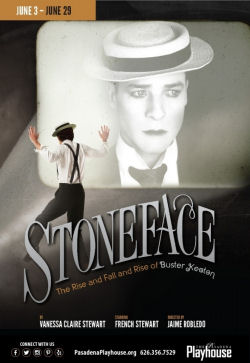
 Recently,
Recently, 